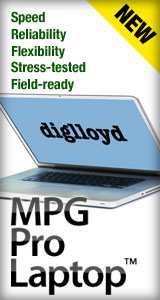
|

|

|

|

|
Conclusions on 2011 Apple MacBook Pro
Related: laptop, Mac Pro, MacBook, MacBook Pro, Macs, memory, Other World Computing, SSD, Thunderbolt, weather events
The 2011 Apple MacBook Pro 2.3GHz quad-core is an astounding leap forward for laptop users. Even compared to the fastest 2010 MacBook Pro Intel Core i7, the 2011 4-core MacBook Pro offers as large a jump in performance as we’ve seen with any Mac, for many years.
It’s almost never the case to see performance go up by 50-100%, yet that’s what Apple has done with the quad-core MacBook pro, up from dual core (the new 13" model looks great, but will perform much more like the 2010 model).
In short, if your work depends on a MacBook Pro in terms of speed, ditch your old model, and don’t walk— run and get the 2011 MacBook Pro 2.3GHz (15" or 17").
Thanks for using our MacBook Pro buying links when you do buy, so we get credit.
Recommendation: opt for the 2.3GHz CPU. The extra cache memory on the 2.3GHz CPU (8MB instead of 6MB) likely has a significant contribution to performance.
Memory limit of 8GB is no more — 16GB is possible
As of March 9, 2011, OWC now offers a 16GB memory kit for the MacBook Pro. For most users, this flings aside the last barrier to using the MacBook Pro instead of a Mac Pro.
Mac Pro substitute?
The 2011 MacBook Pro can now substitute for a Mac Pro for many users— the results show that the requisite CPU power is there, the 16GB memory is enough for just about every use, and by summer 2011, high performance Thunderbolt-based storage devices should appear.
Indeed, the 2.3GHz MacBook Pro outperformed the 2.8GHz Mac Pro at most tasks, with few exceptions, notably those where more than 16GB memory is required.
Other Thunderbolt peripherals are likely to emerge which could make an even more well-rounded platform. In short, we are on the verge of a converged of desktop power in a portable form factor.
Don’t make the CPU idle itself
To consistently realize the gains measured here, you’ll need 8GB of memory (or 16GB), and a fast system drive. Some tasks perform very little disk access, but others do a great deal; the more the disk activity, the greater the need for a fast solid state drive (see the diglloydMedium results).
Upgrading
The MPG Pro Laptop configures a MacBook Pro for peak performance, up to to dual 400GB or dual 480GB internal solid state drives.
For do-it-yourself users, here is a shopping cart with suggested memory and drives at OWC. Choose either the 240GB or 480GB SSD, or you can install two drives by removing the optical drive and using the Data Doubler bracket.

 diglloydTools™
diglloydTools™



